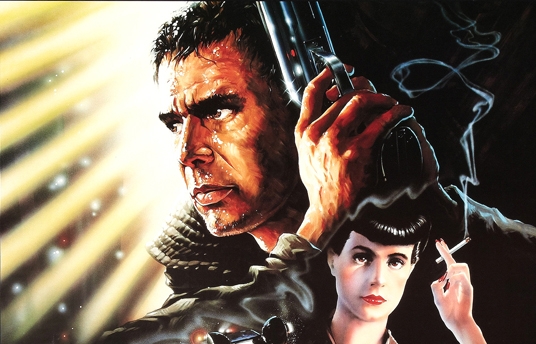نقد سينمائي: بلايد رانر
24 فبراير 2013

ترجمة عروبة حسين
تتراءى أمامنا مدينة لوس أنجلوس فائقة الحداثة وهي تنفث النيران وسماؤها تعجّ بالمركبات الطائرة. هناك أهرام حديثة التصميم تزيد من حدّة آليّة المدينة التي تبدو وكأنها تدير نفسها بنفسها، بينما يتم إطلاعنا على من صنعوا مدينة الحديد والنار والضوء هذه. سرعان ما تتلاشى هذه المشهدية المستقبلية ليحلّ مكانها مشهد مكتب تقليدي بإضاءة زرقاء قاتمة، بينما يتلاعب دوران شفرات مروحة بدخانٍ متصاعدٍ من سيجارة. المبنى الذي تقع فيه هذه الغرفة هو معلم مستقبلي، هو العكس تماماً لديكورها القديم من الداخل. هناك رجلان يجلسان على طاولة، بينما نتعرّف على المخلوقات البشرية المصمّمة جينياً والتي تدعى “ربليكتس”. ينتهي الاجتماع بموت بشري، ينبؤنا بانطلاق رحلة ريتش دكرد (هاريسون فورد) عن المجرمين.
جزء من جمالية فيلم بلايد رانر تكمن في تنقّله بسلاسة بين عالميْن، مازجاً ما بين التكنولوجيا القديمة والشخصيات المصنّعة والسيارات الطائرة. يجعل ذلك تلك المشهدية المستقبلية قريبة من الواقع. فويت كامبف مثلاً هو جهاز للكشف عن الربليكتس. ويقوم هذا الجهاز على مراقبة التنفّس وهي تقنية استخدمها المصريون منذ الألفية الرابعة قبل الميلاد، وتبدو غير مناسبة مع هذا العالم المليء بمستعمرات المخلوقات الفضائية، ولا حدود للتقدّم التكنولوجي فيه. أيضاً استخدام المراوح في أول مشهد استجواب وحين يزور دكرد براينت (أم. إيميت وولش) للتحدث في أمر الربليكتس الأوغاد، يولّد نوعاً من هذا المزيج بين القديم والحديث- بينما يؤمن للمشاهد ألفة معيّنة تجاه هذا العالم الغريب عليه.
إن استخدام هذه المفارقة التاريخية أي التناقض الزمني في بعض العناصر والأشياء، يسمح للفيلم بتبنّي أساليب إخراجية أكثر قدماً. إن أسلوب الفيلم نوار (أي أفلام الجريمة الهوليوودية الكلاسيكية التي سادت بين الأربعينات والخمسينات) يستخدم الاضاءة الخافتة، والتي يزيد من حدّتها عادةً مفتّش، و فام فاتال (أي المرأة المغرية والخطيرة). دكرد يلعب بوضوح دور هذا المفتش، أما حبيبته رايتشل (شون يانغ) هي الفام فاتال، لأن وجودها يزيد من المخاطر. كما أن شقة دكرد والأماكن العدة التي يزورها لديها إضاءة خافتة، وهناك لجوء كبير لاستخدام الظلال والمبالغة بالاضاءة والعتمة. الفيلم برمّته ليس فيه سوى مشهد واحد في وضح النهار – وذلك عند شروقها، أما باقي القصة فتحصل في جنح الليل. هذا النقص في إظهار ضوء النهار يلفت النظر إلى أسلوب “النوار” الذي استخدمه ريدلي سكوت في هذا الفيلم.
في اللحظات الأخيرة للفيلم، يتواجه كل من دكرد وروي باتي (روتغر هور) في مبنى برادبوري ، ويحاول الاثنان قتل بعضهما. باتي يمثّل التقدّم التكنولوجي بكل بهائه، ويتمّ جرّه إلى مبنى قديم ليقاتل من أجل ما تبقى من حياته. هذا المزج ما بين القديم والحديث واضح جداً في المشهد الأخير ويلخّص كل التوتّر الناتج عن التقدم الانساني وتبعاته. هذا المبنى متداعٍ، مما يشير إلى الطبيعة الهشّة للتاريخ البشري وكيف يمكن للتطوّر أن يصنع ويدّمر في الوقت ذاته عناصر المجتمع.
أما الشخصيات والأحداث التاريخية فهي مرتبطة بالمشاهد والعناصر التي نراها في الفيلم، مثل علاقة جاي أف سيباستشن (“ويليام ساندرسون”) بمبنى برادبوري، أو ارتباط دكرد بالبيانو الخاص به والصور، والاعجاب التي تكنّه رايتشل لصورة والدتها. وعلى الرغم من أن التطور التكنولوجي الكبير، يدلّ التاريخ الشخصي والأشياء القديمة على بساطة حقبة ما قبل ظهور الربليكتس. بعد ابتكار الربليكتس، يسلحونها بصور وذكريات في محاولة لإضفاء الطابع الانساني عليها. والربليتكس هي كائنات تحب جمع الذكريات، فمعظمها يعمد إلى جمع الصور من أجل أن يصنع لنفسه تاريخاً وهوية.
لكن هذا الأمر محبط بالنسبة لدكرد لأنه قد يعني انتماءه أيضاً لكائنات الربليكتس، بسبب مجموعة الصور الكبيرة التي يملكها. رايتشل هي أول من يقدم هذا الاقتراح الملمح إليه طوال مدة الفيلم. في أحد المشاهد، يحلم دكرد بالبراق وهو يركض في غابة. في المشهد الأخير، يصنع غاف (أدورد جايمس أولموس) براقاً من الأوريغامي ويتركه في ممر شقة دكرد- مما يبيّن أن غاف قادر على اختراق ذكريات دكرد، مما يعني أنه من الربليكتس. ويقول غاف “من المؤسف أنها (رايتشل) لن تعيش! لكن من سيعيش؟ مما يضعنا فجأة أمام الاكتشاف بأن الجميع فعلياً ينتمون إلى هذا الجنس من الكائنات.
وعلى اعتبار أن غاف هو الشخص الوحيد القادر على ابتكار أمر ما من خلال صنع حيوان على طريقة الأوريغامي، فهو يتحوّل إلى مسؤول عن تطور أمر فريد من نوعه. إنه لا يصنع نسخةً بل شيئاً جديداً. إن فكرة الربليكتس تعني صناعة النسخ بالمعنى الصحيح للكلمة، لذلك تخلق صورة الأوريغامي نوعاً من التجاور مع نسخ البشر التي يضجّ بها الفيلم.
إن كنت تظن أن دكرد ينتمي إلى كائنات الربليكتس أو لا، لا يمكن إنكار المتعة البصرية التي يوفرها فيلم “بلايد رانر” الذي يعتبر فيلم خيال علمي كلاسيكي من الثمانينات. السؤال الحقيقي هو “إن كنت في صحراء، وتمشي على الرمال، تنظر فجأة إلى أسفل فتجد سلحفاة ملقاة على ظهرها، وبطنها مشرّع للشمس، وهي تحرّك رجليها محاولةً أن تغيّر وضعيتها، كيف تتصرّف؟
video#1